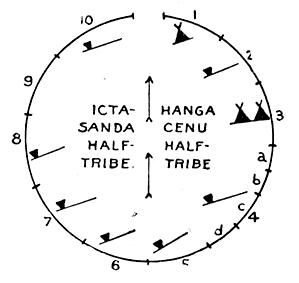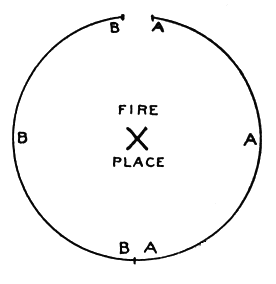| < THE ASINIBOIN | Main Contents | THE PONKA > |
THE OMAHA
The gentes keeping the sacred pipes and those having the sacred tents are designated among the Omaha by appropriate designs. The sacred tent of the Wejiⁿcte was the tent of war, those of the Hañga were the tents associated with the buffalo hunt and the cultivation of the soil. The diameter of the circle (figure 34)
represents the road traveled by the tribe when going on the buffalo hunt, numbers 1 and 10 being the gentes which were always in the van. The tribe was divided into half tribes, each half tribe consisting of five gentes. The sacred tents of the Omaha and all the objects that were kept in them are now in the Peabody Museum of Archaeology and Ethnology at Cambridge, Massachusetts.The two groups of gentes forming the half tribes or phratries, sometimes composed of subgentes or sections, are as follows:
Hañgacenu gentes–1, Wejiⁿcte, Elk. 2, Iñke-sabĕ, Black shoulder, a Buffalo gens; the custodian of the real pipes of peace. 3, Hañga or Ancestral, a Buffalo gens; the regulator of all the so-called pipes of peace and keeper of two sacred tents. 4, C̸atada, meaning uncertain; in four subgentes: a, Wasabe hit‘ajĭ, Touch-not-the-skin-of-a-blackbear; b, Wajiñga c̷ataji, Eat-no-small-birds; Bird people; c,  e-ḍa it‘ajĭ, Touch-no-buffalo-head; Eagle people; d, ʞe-‘iⁿ, Carry-a-turtle-on-the-back; Turtle people. 5, ʞaⁿze, Wind people.
e-ḍa it‘ajĭ, Touch-no-buffalo-head; Eagle people; d, ʞe-‘iⁿ, Carry-a-turtle-on-the-back; Turtle people. 5, ʞaⁿze, Wind people.
Ictasanda gentes–6, Maⁿc̷iñka-gaxe, Earth-lodge-makers; coyote and wolf people. 7,  e-sĭnde, Buffalo-tail; a Buffalo-calf people. 8,
e-sĭnde, Buffalo-tail; a Buffalo-calf people. 8,  a-da, Deer-head; Deer people. 9, Iñgc̷e-jide, Red dung; a Buffalo-calf gens.
a-da, Deer-head; Deer people. 9, Iñgc̷e-jide, Red dung; a Buffalo-calf gens.
![]()
Page 227
10, Icta-sanda, meaning uncertain ("gray eyes"?), said to refer to the effect of lightning on the eyes. This last gens consists of Thunder and Reptile people.
The Iñke-sabĕ formerly consisted of four subgentes. When the gens met as a whole, the order of sitting was that shown in figure 35. In the tribal circle the Wac̷igije camped next to the Hañga gens, and the other Iñke-sabĕ people came next to the Wejiⁿcte; but in the gentile "council fire" the first became last and the last first.
The Iekic̷ĕ or Criers.
The Naqc̷eit‘a-bajĭ, Those-who-touch-no-charcoal.
The three subgentes here named sat on the same side of fireplace.
The Hañga formerly had four subgentes, but two of them, the Wac̷itaⁿ or Workers, and the Ha-ʇu-it‘ajĭ, Touches-no-green(-corn)-husks, are extinct, the few survivors having joined the other subgentes. The remaining subgentes are each called by several names: 1,  esaⁿha-ʇac̷icaⁿ, pertaining to the sacred skin of an albino buffalo cow, or Wacabe, Dark buffalo; or Hañga-qti, real Hañga; or
esaⁿha-ʇac̷icaⁿ, pertaining to the sacred skin of an albino buffalo cow, or Wacabe, Dark buffalo; or Hañga-qti, real Hañga; or  e-c̷eze-c̷atajĭ, Do-not-eat-buffalo-tongues. 2, Jaⁿha-ʇac̷icaⁿ, pertaining to the sacred (cottonwood) bark; or Waqc̷exe-ac̷iⁿ, Keeps-the-"spotted-object" (the sacred pole); or Juⁿ-waqube-ac̷iⁿ, Keeps-the-sacred-or-mysterious-wood (pole); or
e-c̷eze-c̷atajĭ, Do-not-eat-buffalo-tongues. 2, Jaⁿha-ʇac̷icaⁿ, pertaining to the sacred (cottonwood) bark; or Waqc̷exe-ac̷iⁿ, Keeps-the-"spotted-object" (the sacred pole); or Juⁿ-waqube-ac̷iⁿ, Keeps-the-sacred-or-mysterious-wood (pole); or  a-waqube-c̷atajĭ, Does-not-eat-the-sacred (mysterious)-buffalo-sides; or Miⁿxa-saⁿ-c̷atajĭ-kĭ
a-waqube-c̷atajĭ, Does-not-eat-the-sacred (mysterious)-buffalo-sides; or Miⁿxa-saⁿ-c̷atajĭ-kĭ  etaⁿ-c̷atajĭ, Eat-no-geese-or-swans-or-cranes.
etaⁿ-c̷atajĭ, Eat-no-geese-or-swans-or-cranes.
In the tribal circle the Wacabe camped next to the Iñke-sabĕ, and the Waqc̷exe-ac̷iⁿ were next to the Wasabe-hit‘ajĭ sub-gens of the C̸atada; but in the Hañga gentile assembly the positions were reversed, the Wacabe sitting on the right side of the fire and the Waqc̷exe-ac̷iⁿ on the left.
The Wasabe-hit‘ajĭ subgens of the C̸atada was divided into four sections: Black-bear, Raccoon, Grizzly-bear, and Porcupine. The only survivors are the Black-bear and Raccoon (Singers).
The Wajiñga c̷atajĭ subgens was divided into four sections: 1, Hawk people, under the chief Standing Hawk (now dead). 2, Blackbird people, under the chief Wajiⁿa-gahiga. 3, Starling or Thunder people. 4, Owl and Magpie people.
The ʞaⁿze gens was divided into at least two subgentes, the Keepers of the pipe and the Wind people. Lion, of the Deer-head gens, said that there were four subgentes, but this was denied in 1882 by Two Crows of the Hañga gens.
Page 228
The Maⁿc̷iñka-gaxe subgentes, as given by Lion, were: 1, Miʞasi, Coyote and Wolf people. 2, Iⁿ‘ĕ-waqube-ac̷iⁿ, Keepers-of-the-mysterious-stones. 3, Niniba-t‘aⁿ, Keepers-of-the-pipe. 4, Miⁿxa-saⁿ-wet‘ajĭ, Touch(es)-not-swans. Cañge-skă, White Horse, chief of the Maⁿc̷iñka-gaxe (in 1878-1880) named three subgentes, thus: 1, Qube, Mysterious person, a modern name (probably including the Miʞasi and Iⁿ‘ĕ-waqube-ac̷iⁿ, and certainly consisting of the descendants of the chief Wa-jiñgasabe or Blackbird). 2, Niniba-t‘aⁿ. 3, Miⁿxa-saⁿ-wet‘ajĭ.
The  a-da were divided into four parts: 1, Niniba-t‘aⁿ, Keepers-of-the-pipe. 2, Naqc̷e-it‘ajĭ, Touches-no-charcoal, under Boy Chief. 3, Thunder-people, under Pawnee Chief. 4, Deer-people, under Sinde-xaⁿxaⁿ (Deer's-)tail-shows-red-at-intervals (-as-it-bounds-away).
a-da were divided into four parts: 1, Niniba-t‘aⁿ, Keepers-of-the-pipe. 2, Naqc̷e-it‘ajĭ, Touches-no-charcoal, under Boy Chief. 3, Thunder-people, under Pawnee Chief. 4, Deer-people, under Sinde-xaⁿxaⁿ (Deer's-)tail-shows-red-at-intervals (-as-it-bounds-away).
The Ictasanda gens also was in four parts: 1, Niniba-t‘aⁿ, Keepers-of-the-pipe. 2, Real Ictasanda people. (Numbers 1 and 2 were consolidated prior to 1880.) 3, Wacetaⁿ or Reptile people, sometimes called Keepers-of-the-claws-of-a-wildcat. 4, Real Thunder people, or Those-who-do-not-touch-a-clamshell, or Keepers-of-tile-clamshell-and-the-tooth-of-a-black-bear.
The social organization of the Omaha has been treated at length by the author in his paper on Omaha Sociology.1
| < THE ASINIBOIN | Main Contents | THE PONKA > |




